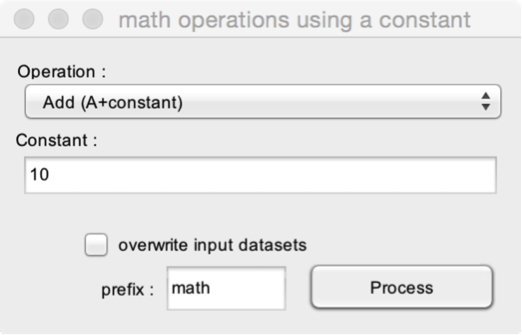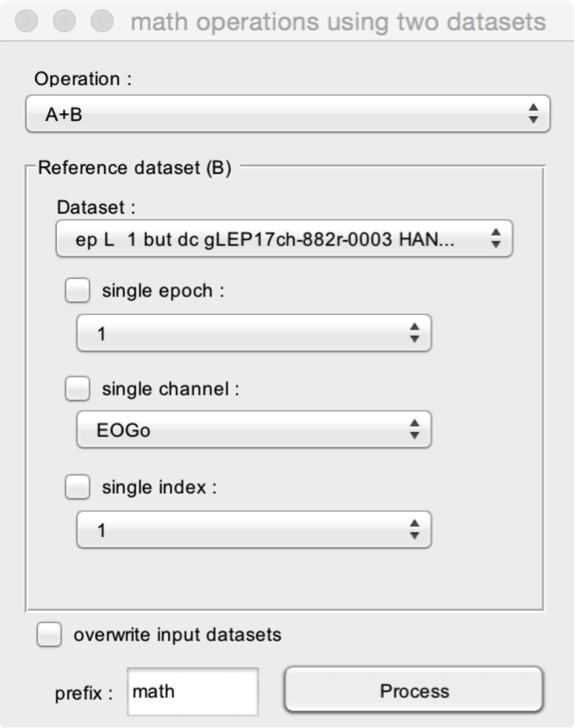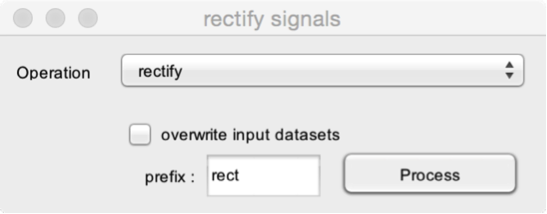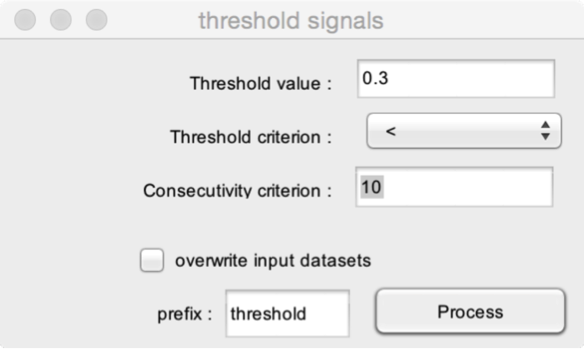-
Notifications
You must be signed in to change notification settings - Fork 30
Math
- Mathematical operations using a constant. Compute simple mathematical operations using one dataset and a constant value.
- Mathematical operations using two datasets. Compute simple mathematical operations between two datasets.
- Rectify or square signals
- Threshold signals. Apply a threshold criterion to the datasets.
- Compute signal derivative
Compute simple mathematical operations using one dataset and a constant value.

- Operation. The operation to perform (add, subtract, multiple, divide).
- Constant. The value of the constant. In this example, a constant value of 10 will be added to the signals of all datasets.
Compute simple mathematical operations between two datasets.

- Operation. The operation to perform (add, subtract, multiple, divide).
- Reference dataset. The operation will be performed on pairs of datasets, referred to as A and B. You must select one dataset as the reference dataset (B).
- Single epoch. If checked, the operation will be performed using a single epoch of the reference dataset (i.e. the operation will be performed using all epochs of A and the selected epoch of B). If unchecked, the operation will be performed using all epochs of A and B (i.e. the operation will be performed using each epoch of A against each corresponding epoch of B).
- Single channel. If checked, the operation will be performed using a single channel of the reference dataset (i.e. the operation will be performed using all channels of A and the selected channel of B). If unchecked, the operation will be performed using all channels of A and B (i.e. the operation will be performed using each channel of A against each corresponding channel of B).
- Single index. If checked, the operation will be performed using a single index of the reference dataset (i.e. the operation will be performed using all indexes of A and the selected index of B). If unchecked, the operation will be performed using all indexes of A and B (i.e. the operation will be performed using each index of A against each corresponding index of B).
Rectify or square signals.

- Operation. You can either rectify signals (compute the absolute value of all samples in the dataset) or square signals (compute the square of all samples in the dataset.
Threshold signals. Apply a threshold criterion to the datasets. This will output a binary dataset, where 0 defines sample positions which did not satisfy the threshold criterion, and 1 defines sample positions which satisfy the threshold criterion.
This binary dataset can then be used as a mask using the function Mathematical operations using a constant.

- Threshold value. The value to be used as threshold criterion.
- Threshold criterion. The threshold criterion. In this example, sample values <0.3 will satisfy the threshold criterion (1), and sample values ≥0.3 will not satisfy the threshold criterion (0).
- Consecutivity threshold. It is possible to consider samples as satisfying the threshold criterion if and only if these samples are surrounded by a number of samples also satisfying the threshold criterion. In this examples, samples will be considered as satisfying the threshold criterion if and only if they are surrounded by at least 10 samples also satisfying the threshold criterion.
Compute the signal derivative. The derivative is computed by subtracting from each sample of the dataset the value measured at the preceding sample of the dataset (yi=yi-yi-1).

Plugins
User interface
File
Edit
Events
- Browse and edit events
- Delete duplicate events
- Create events from level trigger
- Merge event codes and latencies
Pre-processing
- DC removal and linear detrend
- Reference
- Frequency filters
- Spatial filters (ICA)
- Epoch segmentation
- Baseline operations
- Artefact rejection and suppression
- Current source density (CSD)
- Frequency and time-frequency transforms
- Time-frequency filters
- Resample signals
- Resample signals
- Arrange signals
Post-processing
- Average
- Single-trial analysis
- Math
- Source analysis (dipole fitting)
- Find peaks in waveforms
- Global explained variance
Statistics
- Compare datasets against a constant
- Compare two datasets
- Compare more than two datasets (ANOVA)
- Compare signal amplitude at event latencies
- Bootstrap test against a reference interval
Figures